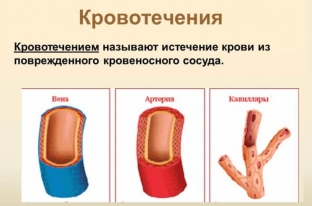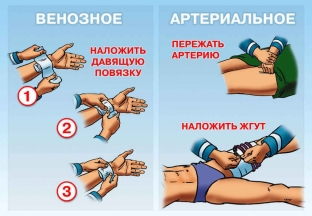During life, we often encounter accidents and first aid, one of the necessary skills for everyone. Today we will look at how to properly provide first aid for bleeding. As you know, an average person contains 5 liters of blood, and the loss of one liter of blood is already a threat to his life.
We often encounter blood loss in everyday life and must respond correctly to the situation. What are the rules for first aid? What to pay attention to when applying a tourniquet?
What are the types of bleeding
Even if you cut your finger, it is already considered bleeding. What types are they divided into:
- Capillary (finger cut, minor skin injury). With such bleeding, the blood does not flow very much and quickly stops. Does not lead to serious consequences.
- Venous (deeper cut, requires pressure dressing, there is a risk of blood loss). With the right help, you can manage on your own.
- Arterial (the most dangerous bleeding, blood spurts in a pulsating fountain, very severe blood loss). With untimely first aid for such bleeding, a person can lose a significant part of the blood supply in a few minutes, which leads to death.

It should be taken into account that for children and the elderly, even minor blood loss can lead to undesirable consequences.
Also bleeding can be:
- External (if blood is visible and it flows from the wound);
- Internal (when blood accumulates inside the body, when internal organs are damaged). One of the most dangerous species, as it is not determined by external signs for a long time and can lead to death.
Proper first aid for bleeding
In case of capillary bleeding (for example: a broken knee), the main thing is to disinfect the wound in order to avoid infection, since the blood does not flow abundantly and does not wash the wound in sufficient quantities.
Venous bleeding is more difficult to stop: you need to apply a pressure bandage and press it firmly against the wounded area. Even if the bandage is completely saturated with blood, it is not recommended to remove it until the bleeding stops completely. Next, you need to seek medical help, you may need to sew up the wound. In any case, a specialist consultation will not be superfluous.
Arterial bleeding requires a quick response to the situation, as everything happens at lightning speed. First you need to pinch a large artery near which the injury occurred:
- If the wound is near the temple, the temporal artery, located in front of the earlobe to the cheekbones, is clamped.
- If the wound is on the neck, the carotid artery is pressed against the spinal area.
- If the wound is on the arm, the brachial artery is pinched.
- If on the leg – main artery of the upper thigh.
However, it must be taken into account that even a physically strong person cannot perform such actions for a long time, since they require considerable effort. Therefore, while you are waiting for medical attention, the victim may need to apply a strong compressive bandage or tourniquet.
Proper application of a tourniquet or dressing during first aid for bleeding
If the wound is in the lower part of the limbs, it is possible to stop the blood pressure by bending the elbow or knee at the joint to the limit.
A pressure bandage should be applied as follows: cover the wound with a sterile bandage or cloth disinfected with any means, teaches estet-portal.com. A roller is placed (any improvised means are useful to make it), and it is bandaged to the wound. In this case, you need to continue to press on the wound. If possible, raise the affected limb above the body to reduce blood pressure.

When applying a tourniquet, if the blood cannot be stopped otherwise, you need to be very careful. If you don't have a harness, a rubber hose or something similar might work. It is applied above the wound, preferably on clothing. On the first circle – we fix the tourniquet, then we make 3-4 turns around. It is superimposed very quickly.
Be sure to write the date and time of the overlay in any conspicuous place.
In winter, it can be applied for 1 hour, in summer - for 2. If during this time there was no medical assistance, unwind the tourniquet (slowly!) And move it higher. You need to check the limb for the absence of a pulse. Overdoing the tourniquet is very dangerous. If it is not removed for a long time, the death of the limbs is possible, so emergency medical help is needed.
It is forbidden to: touch the affected area with your hands, remove fragments from the wound, remove the bandage.
We hope that these recommendations will not often come in handy for you, but if necessary, you will be armed with the necessary information with our portal.






Add a comment